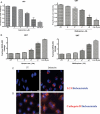Chloroquine-induced autophagic vacuole accumulation and cell death in glioma cells is p53 independent
- PMID: 20406898
- PMCID: PMC2940627
- DOI: 10.1093/neuonc/nop048
Chloroquine-induced autophagic vacuole accumulation and cell death in glioma cells is p53 independent
Abstract
Glioblastoma (GBM) is a high-grade central nervous system malignancy and despite aggressive treatment strategies, GBM patients have a median survival time of just 1 year. Chloroquine (CQ), an antimalarial lysosomotropic agent, has been identified as a potential adjuvant in the treatment regimen of GBMs. However, the mechanism of CQ-induced tumor cell death is poorly defined. We and others have shown that CQ-mediated cell death may be p53-dependent and at least in part due to the intrinsic apoptotic death pathway. Here, we investigated the effects of CQ on 5 established human GBM lines, differing in their p53 gene status. CQ was found to induce a concentration-dependent death in each of these cell lines. Although CQ treatment increased caspase-3-like enzymatic activity in all 5 cell lines, a broad-spectrum caspase inhibitor did not significantly attenuate death. Moreover, CQ caused an accumulation of autophagic vacuoles in all cell lines and was found to affect the levels and subcellular distribution of cathepsin D, suggesting that altered lysosomal function may also play a role in CQ-induced cell death. Thus, CQ can induce p53-independent death in gliomas that do not require caspase-mediated apoptosis. To potentially identify more potent chemotherapeutics, various CQ derivatives and lysosomotropic compounds were tested on the GBM cells. Quinacrine and mefloquine were found to be more potent than CQ in killing GBM cells in vitro and given their superior blood-brain barrier penetration compared with CQ may prove more efficacious as chemotherapeutic agents for GBM patients.
Figures




Similar articles
-
The synergistic effect of combination temozolomide and chloroquine treatment is dependent on autophagy formation and p53 status in glioma cells.Cancer Lett. 2015 May 1;360(2):195-204. doi: 10.1016/j.canlet.2015.02.012. Epub 2015 Feb 11. Cancer Lett. 2015. PMID: 25681668
-
Quinoline-based antimalarial drugs: a novel class of autophagy inhibitors.Neurosurg Focus. 2015 Mar;38(3):E12. doi: 10.3171/2014.12.FOCUS14748. Neurosurg Focus. 2015. PMID: 25727221
-
Autophagy inhibition potentiates SAHA‑mediated apoptosis in glioblastoma cells by accumulation of damaged mitochondria.Oncol Rep. 2018 Jun;39(6):2787-2796. doi: 10.3892/or.2018.6373. Epub 2018 Apr 16. Oncol Rep. 2018. PMID: 29658588
-
Therapeutic exploitation of apoptosis and autophagy for glioblastoma.Anticancer Agents Med Chem. 2010 Jul;10(6):438-49. doi: 10.2174/1871520611009060438. Anticancer Agents Med Chem. 2010. PMID: 20879985 Review.
-
Repurposing Chloroquine Analogs as an Adjuvant Cancer Therapy.Recent Pat Anticancer Drug Discov. 2021;16(2):204-221. doi: 10.2174/1574892815666210106111012. Recent Pat Anticancer Drug Discov. 2021. PMID: 33413069 Review.
Cited by
-
A Screen of FDA-Approved Drugs for Inhibitors of Zika Virus Infection.Cell Host Microbe. 2016 Aug 10;20(2):259-70. doi: 10.1016/j.chom.2016.07.004. Epub 2016 Jul 28. Cell Host Microbe. 2016. PMID: 27476412 Free PMC article.
-
Usp9X Regulates Cell Death in Malignant Peripheral Nerve Sheath Tumors.Sci Rep. 2018 Nov 26;8(1):17390. doi: 10.1038/s41598-018-35806-5. Sci Rep. 2018. PMID: 30478285 Free PMC article.
-
The von Hippel-Lindau tumor suppressor protein promotes c-Cbl-independent poly-ubiquitylation and degradation of the activated EGFR.PLoS One. 2011;6(9):e23936. doi: 10.1371/journal.pone.0023936. Epub 2011 Sep 16. PLoS One. 2011. PMID: 21949687 Free PMC article.
-
Autophagy Benefits the Replication of Egg Drop Syndrome Virus in Duck Embryo Fibroblasts.Front Microbiol. 2018 May 29;9:1091. doi: 10.3389/fmicb.2018.01091. eCollection 2018. Front Microbiol. 2018. PMID: 29896171 Free PMC article.
-
Malaria Prevention, Mefloquine Neurotoxicity, Neuropsychiatric Illness, and Risk-Benefit Analysis in the Australian Defence Force.J Parasitol Res. 2015;2015:287651. doi: 10.1155/2015/287651. Epub 2015 Dec 17. J Parasitol Res. 2015. PMID: 26793391 Free PMC article. Review.
References
-
- Tait MJ, Petrik V, Loosemore A, Bell BA, Papadopoulos MC. Survival of patients with glioblastoma multiforme has not improved between 1993 and 2004: analysis of 625 cases. Br J Neurosurg. 2007;21:496–500. - PubMed
-
- Utsuki S, Oka H, Suzuki S, et al. Pathological and clinical features of cystic and noncystic glioblastomas. Brain Tumor Pathol. 2006;23:29–34. - PubMed
-
- Sotelo J, Briceno E, Lopez-Gonzalez MA. Adding chloroquine to conventional treatment for glioblastoma multiforme: a randomized, double-blind, placebo-controlled trial. Ann Intern Med. 2006;144:337–343. - PubMed
-
- Briceno E, Reyes S, Sotelo J. Therapy of glioblastoma multiforme improved by the antimutagenic chloroquine. Neurosurg Focus. 2003;14 e3. - PubMed
Publication types
MeSH terms
Substances
Grants and funding
LinkOut - more resources
Full Text Sources
Other Literature Sources
Medical
Research Materials
Miscellaneous

